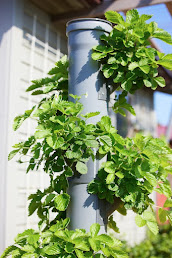Hydroponics farming
Hydroponics
Hydroponics is a method of growing plants using nutrient-rich water instead of soil. This method allows for the cultivation of plants in environments where the soil is not available or not suitable for growth. In a hydroponic system, plants are grown in containers filled with an inert growing medium, such as perlite or coconut coir, and are supplied with a nutrient-rich water solution that is delivered directly to the roots of the plants. Hydroponics can be used to grow a wide variety of plants, including vegetables, herbs, and flowers, and is often used in greenhouses, urban farming, and other controlled-environment agriculture settings.
There are several ways to grow vegetables using hydroponics. Here is one common method:
- Choose the vegetables you want to grow and research the specific requirements for those crops, including the type of hydroponic system and nutrients that are best suited for their growth.
- Set up a hydroponic system. This can be as simple as a container filled with an inert growing medium and a water-nutrient solution delivered directly to the roots of the plants, or it can be a more complex setup with multiple containers, pumps, and other equipment.
- Sterilize the containers and growing medium to ensure that the plants are not exposed to any diseases or pests.
- Plant the seeds or seedlings in the containers, following the specific guidelines for the type of vegetables you are growing.
- Monitor the plants regularly, including checking the pH and nutrient levels of the water-nutrient solution, and making any necessary adjustments to ensure optimal growth.
- Harvest the vegetables when they are fully mature and ready to be eaten.
- Maintain the hydroponic system by cleaning the containers and equipment and replacing the nutrient solution as needed.
It's important to note that growing vegetables using hydroponics requires careful planning and attention to detail, as the plants are completely reliant on the water-nutrient solution for their nutrients and hydration.
The shelf life of hydroponically grown fruits will depend on several factors, including the type of fruit, the storage conditions, and the level of ripeness at the time of harvest. In general, hydroponically grown fruits that are harvested at their peak of ripeness will have a shorter shelf life than those that are picked while they are still underripe.
To extend the shelf life of hydroponically grown fruits, it's important to store them in the proper conditions. For example, most fruits should be stored in a cool, dry place away from direct sunlight. Some fruits, such as avocados and bananas, will continue to ripen after they are picked, so they should be stored at room temperature until they are ready to be eaten. Other fruits, such as berries and grapes, are highly perishable and should be stored in the refrigerator to help extend their shelf life.
Overall, the shelf life of hydroponically grown fruits will vary depending on the specific type of fruit and the storage conditions, but in general, they will last longer if they are picked at the right stage of ripeness and stored in the appropriate conditions.
Where Hydroponic is used?
Hydroponics is used in many countries around the world, with some of the largest hydroponic farming operations occurring in the Netherlands, Japan, the United States, and Canada. However, hydroponics can be used to grow plants in any country, as it allows for the cultivation of plants in environments where the soil is not available or not suitable for growth. For example, hydroponics is often used in desert regions where water is scarce and soil conditions are not conducive to traditional agriculture. It is also used in urban areas where there is limited space for farming, such as on rooftops or in greenhouses. In addition, hydroponics can be used to grow crops in areas where the soil is contaminated or otherwise unfit for agriculture.
Future of hydroponic:
The future of hydroponics looks bright, as this method of growing plants has many potential benefits and applications. Some of how hydroponics may be used in the future include:
- Increasing food production: Hydroponics allows for the cultivation of crops in environments where traditional agriculture may not be possible, such as in urban areas or regions with poor soil quality. This could help to increase global food production and address issues of food security.
- Reducing water usage: Hydroponics uses significantly less water than traditional agriculture, as the water-nutrient solution is delivered directly to the roots of the plants and can be reused multiple times. This makes hydroponics an attractive option in areas where water is scarce.
- Improving food safety: Hydroponics can be used to grow crops in a controlled environment, which reduces the risk of contamination from pests and diseases. This could help to improve the safety of the food supply.
- Reducing the carbon footprint of agriculture: Hydroponics can be used to grow crops in greenhouses, which reduces the carbon footprint of agriculture by eliminating the need for the transportation of crops over long distances.
- Providing a source of fresh, local produce: Hydroponics can be used to grow a wide variety of crops year-round in urban environments, providing a source of fresh, locally grown produce for consumers.
Overall, the future of hydroponics looks promising, as this method of growing plants has the potential to address many of the challenges facing traditional agriculture, such as limited land availability, water scarcity, and food safety.











No comments
Post a Comment